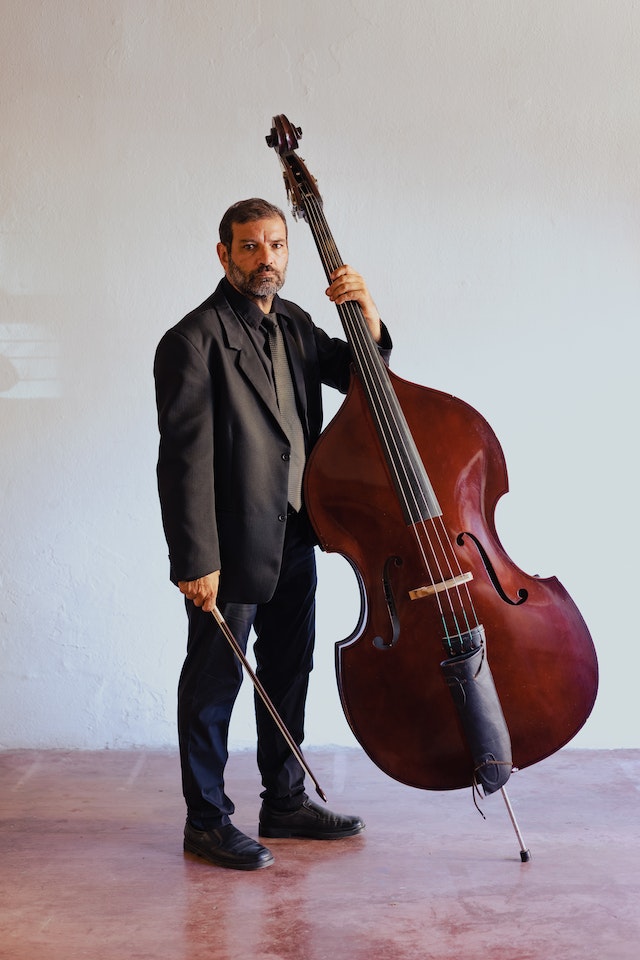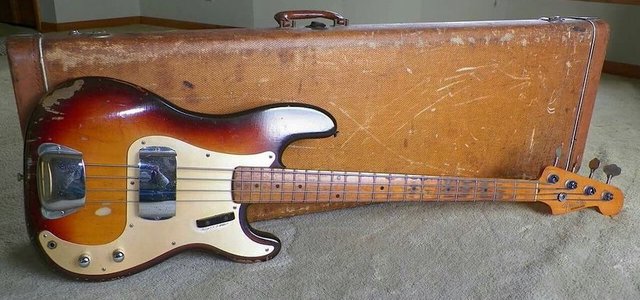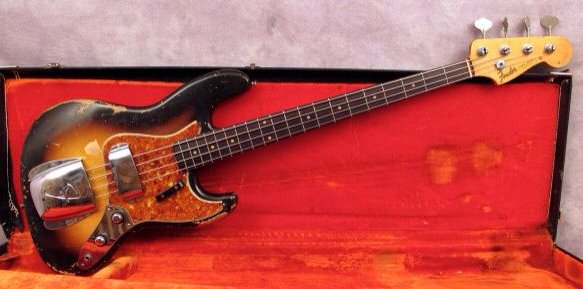Bass guitars are one of the most widely used and probably one of the most underrated instruments in modern music. While lead guitarists and drummers are often the center of attention, the bassist bridges the gap between the different sections of the music, making the song come alive.
In this article, we will look at the history of the bass guitar, its origins, usage, and the people responsible for its design and development from the initial stage to modern times.
Modern bass guitars are a successor to upright bass or double bass. The double bass is a large cello–like instrument still popular among some musicians in specific genres.
The 1930s: Bass Guitar is Invented

Photo courtesy: moonshinegtrs
Paul Tutmarc developed the bass guitar in its modern form in 1935–1936, named the Audiovox Model 736 Bass Fiddle. Fitted with an electronic pickup, Model 736 was small and portable. It also used a different bass amp specifically designed for it that Paul’s company Audiovox sold.
Paul Tutmarc himself was multi–talented. He was a singer, an inventor and a teacher of lap steel guitars (a stringed instrument quite different in looks than a standard guitar) and ukulele.
Model 736 was a solid–body guitar with a scale length of 31.5 inches. This is smaller than standard modern basses that have a scale length of 34–35 inches. Unlike double bass, these bass guitars were meant to be played horizontally like the modern basses.
Despite being a revolutionary design that inspired the bass guitars of later decades, Model 736 was not a big success then, and the double bass remained the instrument of choice for bassists until the 1950s.
What is a Double Bass?

The double bass is a large and heavy stringed–instrument often played with a bow in an upright position. The instrument sits on the floor, which is why it is also called an upright bass. It looks similar to a cello or a giant violin and is an acoustic instrument.
Lower-end frequencies require more energy to produce an audible sound, which is why these instruments are huge. This is why sometimes, when playing along, even with an acoustic guitarist in a band, the guitar would usually overpower the bass despite being magnitudes smaller.
The popularity of double bass decreased considerably in the 1950s as many players switched to bass guitars for their ease of playing and portability.
In modern times, the double bass is prevalent in classical western music, jazz, and 1950s–style rock music.
The 1950s: First Mass–Produced Electric Bass Guitar

Leo Fender is one of the most well–known figures in the guitar industry and the founder of Fender. In 1950, Fender and George Fullerton revolutionized the bass instrument industry with the development of the modern style electric bass called the “Precision Bass”.
Soon after its introduction, these bass guitars started to replace the heavier double bass. The P–Bass, as they are sometimes called, were easier to carry, and the electronic amplification proved to be better for live performances.
Additionally, double bass used piezoelectric pickups and suffered from feedback issues that the new P–Bass with its magnetic pickups completely solved.
Monk Montgomery became the first famous musician to tour with a Fender Bass Guitar in 1953, making the bass guitar an instrument of choice for several other bassists.
Fender Precision Bass or P–Bass is believed to have set the industry standards for bass guitars, and several companies started producing similar guitars in the 1950s and 1960s.
After the success of the P–Bass, in 1953, Gibson released their first bass guitar, the EB–1. It was designed similar to a double bass rather than taking inspiration from the P–Bass. EB–1 could be played both upright and horizontally, but it wasn’t a major success.
The EB–1 was followed by EB–2 in 1958 with a design akin to contemporary bass guitars. However, unlike P–Bass and other bass guitars of the time, Gibson’s EB–2 and other bass guitars were all short–scale (30.5 inches).
The EB–2 had humbucker pickups and two knobs, one for volume and one for tone. A later version of the EB–2 had a baritone/bass selector switch that either cut or enhanced the bass frequencies giving the guitar two distinct tones.
In 1959 Gibson introduced the EB–0, one of the more successful bass guitars of its time. EB–0 had the same shorter scale length but with a larger humbucking pickup, which produced a very distinct low end. However, not all people were thrilled; some found the tone to be muddy, and many aftermarket pickups were available for the EB–0. Regardless, the EB–0 continued its production and success until 1979.
The 1960s: Fender Jazz Bass

With the impact of the P–Bass on the music industry and the rapid rise in popularity of rock and roll, Fender introduced a second bass guitar model in 1960 known as the Fender Jazz Bass.
Despite the name, it was popular with bass players of all genres, including rock and blues. In the 1960s, Fender was still the most popular bass guitar producer in spite of other companies like Yamaha and Gibson starting to manufacture similar bass guitars.
In 1961 Fender added another bass guitar to their line–up, but this time with a shorter scale called the Mustang Bass. It had a 30–inch scale length and came fitted with split–coil bass pickups.
Following this, Gibson introduced another bass guitar in 1961, the EB–3, with a similar short scale. Successor to the EB–2, this new bass had two pickups, one at the neck and another mini-humbucker at the bridge position. The EB–3 had four knobs — a volume knob and a tone knob for each of the two pickups. It also included a 4-way selector switch for the pickups to alter the tone.
The 1960s also saw the introduction of the first commercial 6–string bass in 1961, known as the Fender VI. It had the same tuning as a standard 6–string guitar but an octave lower, unlike modern 6–string bass guitars.
In 1966 the first commercial fret–less bass guitar was introduced and was called the AUB–1 or Ampeg Unfretted Bass–1. Ampeg, the company behind this, has been famous for its amps since the 1950s and still remains one of the most popular bass amp manufacturers.
The 1960s, therefore, marks one of the most important decades for not only bass guitars but also rock music. Although bass guitars in their current form and design were still new, they were quickly becoming more popular.
The 1970s: Active Bass Guitars
A newcomer in the market, Alembic, introduced a high–end line of bass guitars. These bass guitars included an inbuilt electronic system for pre–amplification and frequency equalization. These “active bass guitars” had knobs to increase or decrease the output of specific frequency ranges (like most amps), giving the players better control over the output tone.
A passive bass guitar could only cut off certain frequency–ranges. On the other hand, active basses could cut off and boost the lows, midrange and treble ranges, giving bassists more control over the tone.
Known for revolutionizing the bass guitar industry, Leo Fender found himself in a dire situation with a health issue that affected his business. After a series of events, Leo Fender sold his company Fender to CBS, which kept the original company name. Thankfully, Leo Fender survived and later founded two other music companies.
In 1974, Leo Fender was contacted by Forrest White and Tom Walker to design a new bass guitar. Thus was born the company Music Man Instruments and their first guitar — StingRay. It was the first mass–produced active bass guitar and was known for its punchy bass sound and high–quality build. It is still in production and regarded as one of the best bass guitars of all time.
The 1970s also saw the introduction of five– and six–string bass guitars. Unlike the Fender VI, these bass guitars had a different tuning than guitars. The 5–string variant had an additional low string tuned to B, while the 6–string version had two extra strings — one low B and one high C. This is the same tuning that modern 5– and 6–string bass guitars are tuned.
Final Thoughts
Upright bass, the standard stringed instrument before the 1950s, can be attributed to lending its design to bass guitars. Through the 1950s and 1960s, bass guitars took shape and form that has more or less stayed the same ever since, even though the pickup system and electronics have improved considerably.
Today, bass guitars are more popular than ever, as many genres, from funk to new age and from jazz to pop, use them in their songs and performances.


